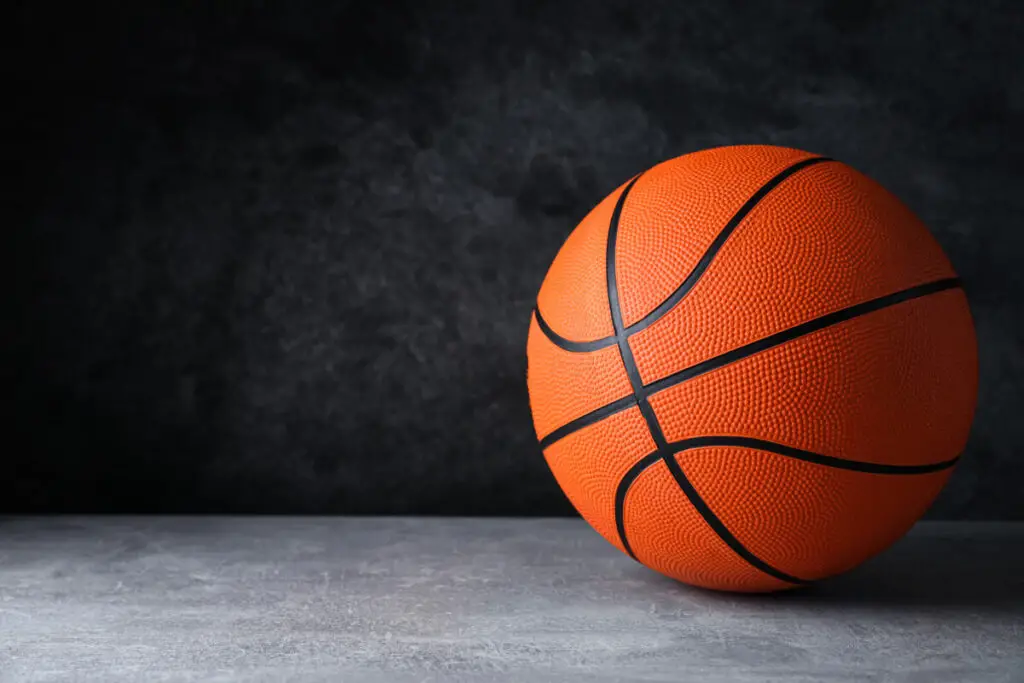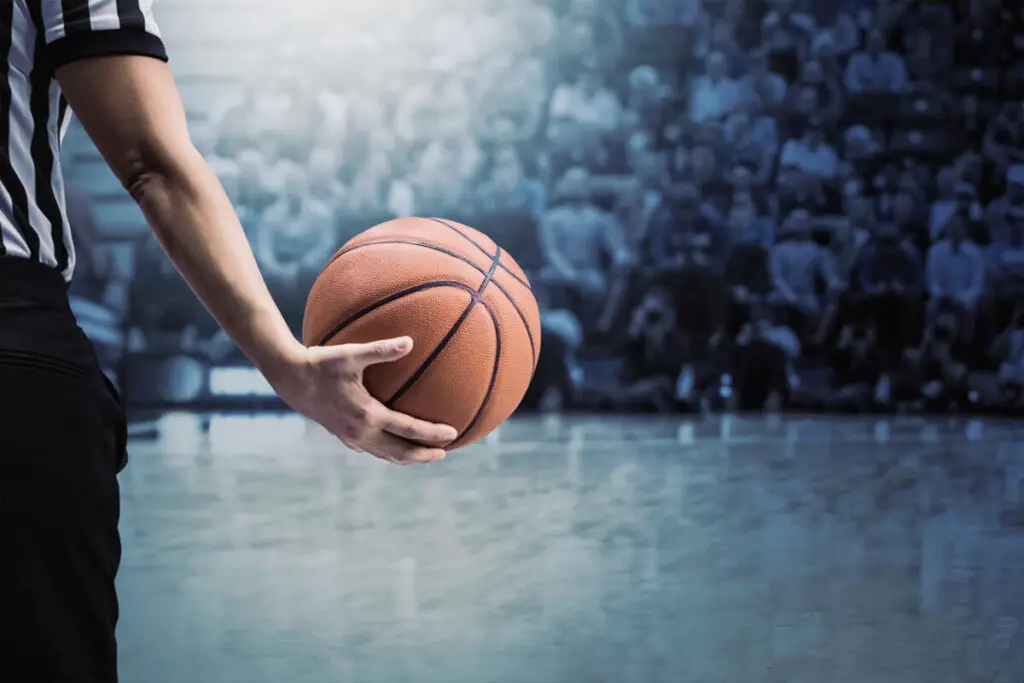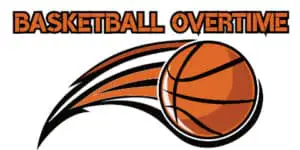
Basketball is an extremely popular sport. If you aren’t gathered around the TV watching March Madness, then you’re at the gym enjoying a high school basketball game. No matter where you watch the sport, the beginning of the basketball game might seem a bit confusing.
Every basketball game, whether professional or unprofessional, starts with a jump ball. The team that wins the jump receives possession of the ball, while the team that loses the jump will start with the ball at the beginning of the next quarter. Possession alternates at the start of every quarter.
To really get into the game of basketball, you need to fully understand the rules. What better place to start learning than how the game starts? Keep reading to learn more about the rules of basketball!
The Start of a Basketball Game
When you arrive at a basketball game, you’ll probably see all the players on the court practicing passing and shooting. But this isn’t how the game starts. This is merely the warmups. You will also see a timer on the scoreboard. When there is only a minute or two left on the scoreboard, all the players will run back to their team’s sideline for a quick pregame huddle. And now, it is time to start the game.
Before you can start the game, you need to know how many players you’ll need. While most basketball teams have at least 12 players, only five are allowed on the court at a time. If you want to switch players, you’ll have to wait for a break in play to make a substitution.
At the start of a basketball game, five players from each team will line up around the half-court line. In the center of the court, there is a circle. This circle is referred to as the “jump circle.” Allowed inside the jump circle are two players, one from each team, and a referee. The other players will spread out around the circle and wait for “the jump.” Cramming three people into a tight space can lead to some funny situations, like the one in the video below!
The jump is quite literally a jump. The referee will throw the ball into the air and the two players will attempt to hit it to one of their teammates—this is called the tip-off. The jumpers must wait until the ball has reached its highest point before they can touch it. Additionally, the players cannot grab or hold onto the ball during the jump. Hence the name “tip-off,” not “grab.”
When reaching for the ball, the jumpers can only touch the ball twice. Another player must gain possession of the ball before they can touch it again. Additionally, the jumpers can only “tip” the ball using one hand. If the jumper touches the ball with both hands, it will be considered a violation of the rules.
The jumpers aren’t the only ones restricted by tip-off rules. All players on the court must follow two rules until the jump is over. First of all, no other players are allowed inside the jump circle until the game has started. Secondly, none of the players on the court, apart from the jumpers, can move until the ball has been tipped. Violating either of these rules will result in an automatic loss of possession.
Watch an example jump ball take place in the following video!
The tip-off decides which team gets possession of the ball. As the players in the center circle jump, their job is to get the ball into the hands of their teammates. But wait for a second, what is possession and why does it matter?
Possession is kept track of throughout the game by the refs and the scorekeeper. Which team has possession of the ball is kept track of with an arrow located at the scorekeeping desk and on the scoreboard for the entirety of the game. Possession matters because only the team in possession of the ball can attempt to score a basket. Additionally, previous possession is used in instances when the referees are unsure who gets the ball. We’ll discuss this more in-depth in a later section.
When looking at the possession arrow after the jump takes place, you might be confused to see that the arrow points opposite of the team that won the jump. This is because the possession arrow doesn’t show who currently has possession of the ball. Instead, the arrow points as to who gets possession next.
Possession of the ball isn’t claimed until a player other than the jumper grabs the ball. This doesn’t mean touching the ball—it means holding the ball securely.
So what happens if no one gets a solid hold on the ball before it rolls out of bounds? Possession will go to the team who didn’t touch the ball last.
If the tip-off results in two players both holding the ball, the referees will call another jump ball. However, the two players battling for possession will be the ones in the center circle. This is a rarely occurring scenario, and you probably won’t encounter it.
In less competitive environments or matches, sometimes a toss of the coin is used to decide who starts with the first possession. In this case, a referee or a selected person will toss a coin, with both teams choosing a side of the coin. The team that chose the side that is showing when the toss is finished will be the one starting with the game. To start the game, one player will be in the middle of the court, outside the court, and assist a team player, the same that is done at the start of all the other quarters in professional basketball. Below you have an example of how this would play out.
Alternatively, and especially in 3×3 basketball, teams shoot free throws until one of the teams misses one. In this case, the team that didn’t miss starts with the possession. Sometimes, three-pointers are chosen instead of free throws. In this case, and depending on the level of the players, the team that starts is the team that first scores.
How to Choose Who Jumps
Almost more important than knowing the rules of the jump ball is knowing who to choose as your jumper. In most cases, you want the tallest person on your team to participate in the jump. This person is usually the center.
The center typically stays close to the basket during the game because of their height advantage during rebounds. Similarly, the center’s responsibility is to block the opposing team’s attempts to score. Watch the following video to see some of the best plays made by NBA centers during the 2017 season!
The only time a coach would put another player in the jump circle is if they can jump higher than the center. The higher the player can reach, the better chances the team has to win the tip-off. So if you’re hoping to become your team’s new jumper, start working on the height of your hops.
If you’re playing in a non-competitive basketball league, also known as an intramural league, it is okay to rotate which player participates in the jump. While this is a critical part of competitive basketball, players will enjoy the chance to take part in this fun battle for the ball.
Jump Balls: What Are They?
While the game starts with a jump, there are a series of jump balls throughout the game; however, none of these actually require the players to jump (in most cases).
A referee may call a jump ball for a variety of reasons. When they do, they will consult the possession arrow and award it to the team it’s pointing toward. When the ball returns to play, the direction of the possession arrow switches. This process repeats every time a jump ball gets called.
So why might a referee call a jump ball? The first reason for a jump ball is if two players both have a hold on the ball. To prevent the players from injuring each other, the referee will call a jump ball. They will signal that they are calling a jump ball with two thumbs up while blowing the whistle. Play stops and the two players will let go of the ball.
The referee will then consult the possession arrow and award it to the team that it is pointing at. A player from that team will take it to the edge of the court and throw it back into play. As soon as the ball enters into play, the scorekeeper will change the direction of the possession arrow.

Another reason that the referees will call a jump ball is if they aren’t sure who touched the ball last before it went out of bounds. This is more likely to happen if there are multiple players standing around the ball. With their view of the ball blocked, the referee has no choice but to call a jump ball.
A player from the selected team will throw the ball back into play from the area where it went out of bounds. When the ball goes back into play, the scorekeeper will change the direction of the possession arrow.
Basketball: How long is a quarter?
As mentioned earlier, possession of the ball alternates at the beginning of every quarter. But how long is a quarter and how many of them are in a basketball game?
As the term implies, there are four quarters in every basketball game. However, the length of the quarter varies depending on the level at which the game is being played.
For example, middle school and high school basketball games both have four 8-minute quarters. Meanwhile, college basketball games are comprised of four 10-minute quarters. The quarters get even longer when the game reaches the NBA level. NBA basketball games consist of four 12-minute quarters.
In between the quarters, there are small breaks when the players can rest. The length of these breaks is the same regardless of the level the game is being played at. In between the first and second quarters, there is a short 2-minute break. This break is used to give the players a short rest as well as to provide the coaches time to strategize with their teams. Another 2-minute break takes place between the third and fourth quarters.
In between the second and third quarters, there is a longer break. This break is referred to as “half-time.” High school and middle school basketball games will have a 10-minute half-time. However, if the game is running long, the referee may choose to shorten the length of the half-time. This is more common for middle school games.
Both college and NBA basketball games have a half-time of 15 minutes.
If, at the end of the fourth quarter, both teams have the same score, a fifth quarter will be added. This quarter is referred to as “overtime.”
The overtime period in a middle school or high school basketball game is only four minutes long. Meanwhile, both college and NBA basketball games have an overtime period of five minutes long. If both teams are still tied at the end of the overtime, the referees will add another overtime period to the game.
Before the overtime period starts, there will be a short one-minute break.

Even though the quarters of a basketball game have a time limit, they often go for much longer. The main reasons that this occurs are timeouts and dead balls. Each of these instances requires the clock to stop running. So how do each of these things work? Let’s take a closer look at how timeouts influence the length of the quarter.
Time Outs
In both high school and middle school, both head coaches receive five timeouts; however, not all timeouts are the same length of time. The coach can call three one-minute timeouts and two 30-second timeouts each half.
Because NBA and college basketball games are occasionally broadcasted on TV, they must use a different timeout system.
When a college basketball game isn’t filmed for television, the coach gets four 75-second timeouts and two 30-second timeouts each game. That’s right, the timeouts do not reset at the beginning of the second half. Instead, the coach must budget their timeout usage more wisely.
If the game is being filmed for television, then each coach receives one 60-second timeout and three 30-second timeouts per game. Their other timeouts are supplemented by “media timeouts.” Since the game is on TV, they use media timeouts to avoid missing any plays during a commercial break. Media timeouts take place at the first dead ball (when the ball goes out of bounds or a player fouls) after the time remaining in each half is under 16, 12, 8, and 4 minutes. In other words, there are four media timeouts each half.
However, media timeouts can occur at the same time as a regular timeout. This happens when a coach calls a timeout within 30 seconds of the media timeout.
In NBA basketball games, each coach gets seven timeouts per game, each lasting 1 minute and 15 seconds. Additionally, there are two mandatory timeouts for each quarter. These timeouts take the place of the media timeout. These timeouts will not be implemented so long as a timeout is called prior to the seven and three-minute marks of the quarter.
